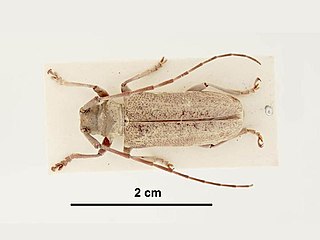
The longhorn beetles (Cerambycidae), also known as long-horned or longicorns, are a large family of beetles, with over 35,000 species described.

Bandipur National Park is a national park covering 868.63 km2 (335.38 sq mi) in Chamarajnagar district in the Indian state of Karnataka. It was established as a tiger reserve under Project Tiger in 1973. It is part of the Nilgiri Biosphere Reserve since 1986.

Sulfuryl fluoride (also spelled sulphuryl fluoride) is an inorganic compound with the formula SO2F2. It is an easily condensed gas and has properties more similar to sulfur hexafluoride than sulfuryl chloride, being resistant to hydrolysis even up to 150 °C. It is neurotoxic and a potent greenhouse gas, but is widely used as a fumigant insecticide to control termites.

Bambusa vulgaris, common bamboo, is an open-clump type bamboo species. It is native to Indochina and to the province of Yunnan in southern China, but it has been widely cultivated in many other places and has become naturalized in several regions. Among bamboo species, it is one of the largest and most easily recognized.

Cerylonidae are small to tiny, smooth, shiny, hairless beetles, only lightly punctured. There are about 450 species worldwide in 50 or so genera, mostly tropical and subtropical. They are most common under the bark of dead trees, but can also occur in compost and other decaying plant material. Little is known specifically about their biology but they are thought to be either predators that feed on other small animals, or fungus-feeders.

Tropical evergreen forests of India are found in the Andaman and Nicobar Islands, the Western Ghats, which fringe the Arabian Sea, the coastline of peninsular India, and the greater Assam region in the north-east. Small remnants of evergreen forest are found in Odisha state. Semi-evergreen forest is more extensive than the evergreen formation partly because evergreen forests tend to degrade to semi-evergreen with human interference. There are substantial differences between the three major evergreen forest regions.The average annual rainfall is 65-75 inches.

Bamboo shoots or bamboo sprouts are the edible shoots of many bamboo species including Bambusa vulgaris and Phyllostachys edulis. They are used as vegetables in numerous Asian dishes and broths. They are sold in various processed shapes and are available in fresh, dried, and canned versions.

Antheraea paphia, known as the South India small tussore, the tasar silkworm and vanya silkworm is a species of moth of the family Saturniidae found in India and Sri Lanka. The bulk of the literature on this species uses a junior synonym, Antheraea mylitta, rather than the correct name, A. paphia. It is one of a number of tasar silkworms, species that produce Tussar silk, a kind of wild silk that is made from the products of saturniid silkworms instead of the domesticated silkworm.

Chlorophorus is a genus of round-necked longhorn beetles belonging to the family Cerambycidae, subfamily Cerambycinae.

Eburia tetrastalacta is a species of beetle in the family Cerambycidae.
Na Yung–Nam Som National Park is a national park in Nam Som District, Udon Thani Province, Thailand.
Phytoecia gianassoi is a species of beetle in the family Cerambycidae. It was described by Sama in 2007 and later reclassified to the subgenus Coptosia within the genus Phytoecia.

Acalolepta vastator is a species of beetle in the family Cerambycidae. It was described by Newman in 1841, originally under the genus Monohammus. Breuning erroneously synonymised this species with Acalolepta mixta. It is found throughout eastern Australia, including Tasmania and South Australia, as well as parts of South Asia. The Australian government recognize this species as a pest species. It feeds on grape vine, papaya and curtain fig tree.

Oemona hirta, the lemon tree borer, also known as the whistling beetle or the singing beetle, is a longhorn beetle endemic to New Zealand. Its larvae are generalist feeders, boring into the wood of a wide variety of trees, native and introduced. When citrus orchards were first established in New Zealand, this beetle started inflicting serious damage, and so gained the name "lemon tree borer". Four species within the genus Oemona have been identified, suggesting that more species could be found. When disturbed by predators or humans, the adult beetle stridulates creating a "rasp" or "squeak" sound by rubbing its thorax and head together against an area of thin ridges. Māori would eat a liquid called "pia manuka", which was produced by manuka trees when its wood was damaged by the larvae. When Captain Cook first arrived in NZ, his naturalists, Banks and Solander, collected a lemon tree borer in their first collection between 1769 and 1771. This oldest collected specimen can be found in the British Museum. A few years after the first collection, the species would be first described by the Danish naturalist Fabricius in 1775.

Madhupur National Park is a major and one of the earliest national park in Bangladesh.

Purpuricenus sanguinolentus is a species of longhorn beetle native to Sri Lanka and India and possibly in China.

Neoplocaederus obesus, commonly known as Cashew stem borer or Red cocoon-making longhorn, is a species of longhorn beetle native to South Asian and South East Asian countries.
Gelonaetha hirta, commonly known as Hibiscus Long-horned beetle, or Long horn teak borer, is a species of longhorn beetle. It is distributed in Sri Lanka, India, Myanmar, Thailand, Laos, Hainan Island, Taiwan, Borneo, Philippines, Micronesia, Polynesia and West Indies.
Xylosandrus mancus, is a species of weevil found in Afrotropical and Oriental regions.















